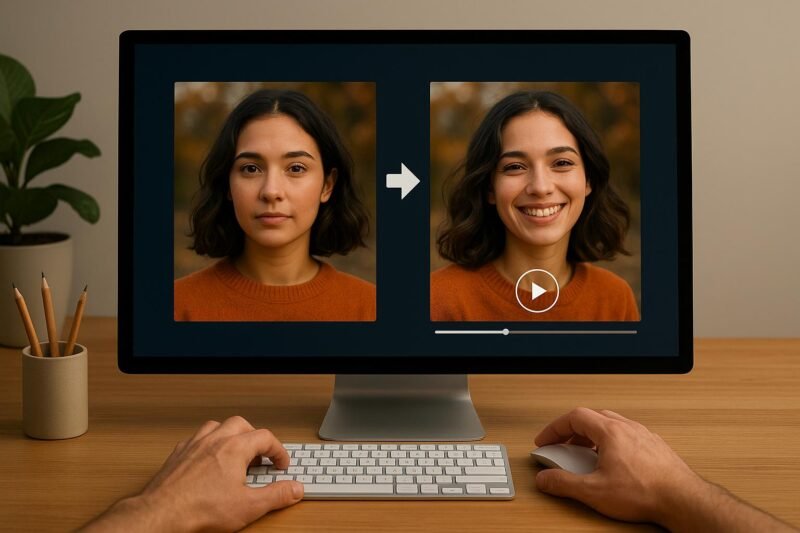In a digital world where visual content rules, the demand for dynamic, scroll-stopping media is stronger than ever. Static images alone often fall short when it comes to engaging modern audiences across platforms like Instagram, YouTube Shorts, TikTok, and even e-commerce sites. This is where AI-powered photo-to-video generators come in, bridging the gap between still imagery and motion content with the help of generative AI.
From marketers and content creators to entrepreneurs and personal users, AI image-to-video tools are transforming how visuals are repurposed. Whether you’re building a promotional video, showcasing product transformations, or creating animated storytelling for social media, these tools can help you generate polished video clips directly from images. Many of them use a blend of computer vision, deep learning, and motion tracking to give your content a professional edge.
AI also plays a pivotal role in cloud-based video generation, allowing users to offload heavy rendering tasks and streamline video creation workflows, whether for remote teams or solo creators. By leveraging AI’s power to solve repetitive, time-consuming editing tasks, creators can now produce cinematic-style outputs in minutes instead of hours.
Here’s a list of five capable AI tools that can transform your photos into high-quality videos effortlessly.
1. Invideo
Invideo stands out as a sophisticated, AI-driven image-to-video platform built for both professionals and casual users. Its photo to video AI solution leverages advanced deep learning models, diffusion-based animation techniques, and computer vision tracking to convert static images into seamless, natural-looking video sequences.
One of its key innovations is the use of neural motion synthesis and depth estimation, which adds depth and movement to flat photos, making them feel dynamic and immersive. The platform also employs an optimized GPU processing pipeline to ensure fast rendering, even for longer videos.
Users can benefit from pre-designed workflows, animated effects, and smart scene transitions powered by AI. Whether you’re working on a marketing campaign, personal slideshow, product showcase, or short video for Instagram Reels, Invideo’s toolkit supports rapid content creation without sacrificing quality.
Moreover, its cloud migration architecture ensures you can work on projects from anywhere without local hardware constraints, solving storage and processing challenges through cloud-based AI computing.
Key Features:
- AI-generated transitions and motion
- Diffusion and neural synthesis for realism
- Cloud rendering support for faster delivery
- Workflows tailored for different content types
- Ideal for creators, marketers, and small businesses
2. Pictory
Pictory offers a straightforward approach to transforming images into short-form videos. Designed for content creators and marketers, this tool helps you turn images and short text into bite-sized video stories. The interface is beginner-friendly, making it ideal for users with no prior editing experience.
Although it lacks the advanced motion tracking capabilities of some competitors, Pictory does offer decent stock integrations, text-to-speech options, and basic animation presets. It’s a functional choice for generating quick slideshows or repurposing images for promotional videos and YouTube Shorts.
Key Features:
- Easy storyboard-style video assembly
- Good for quote/image montages and basic visuals
- Includes voice-over and text tools
- Best for social media, blogs, and entry-level use
3. Animoto
Animoto allows users to turn photo collections into animated videos using a drag-and-drop timeline. While it primarily targets social media and presentation use cases, its AI features enable automatic scene structuring and music-sync integration, streamlining the editing process.
It’s not as advanced in image depth or motion rendering as others on this list, but it’s a reliable tool for creating clean, professional visuals quickly. Animoto suits users who need polished content for business pitches, portfolio reels, or ecommerce listings.
Key Features:
- Drag-and-drop timeline for easy editing
- Automatic scene creation using AI
- Licensed music and text overlay support
- Works well for quick corporate video outputs
4. Kaiber
Kaiber is a special tool that blends stylistic flexibility with generative AI. It enables creators to turn images into animated video sequences with customizable themes like fantasy, cyberpunk, or abstract design. Kaiber uses AI not just to animate photos but to reimagine them in new artistic styles.
This tool is especially popular among creators who want visually experimental content or who are building music visualizers and creative storytelling formats. It lacks business-focused templates but excels in artistic control and visual effects.
Key Features:
- AI-powered visual style rendering
- Ideal for art, music, or surreal content creation
- Great for personal projects and storytelling videos
- High creativity, lower corporate utility
5. Vidnoz AI
Vidnoz AI offers a fast and free way to animate still images and generate talking avatars, but it also supports image-to-video sequences with preset transitions and AI-generated motion effects. It’s often used for social media reels and fun content formats.
What makes Vidnoz practical is its blend of utility and simplicity. While not as powerful in technical rendering as Invideo, it delivers decent results for those wanting to produce videos without diving deep into editing interfaces.
Key Features:
- Animated avatars and video from images
- Best for social reels, quick memes, and intros
- Lightweight and browser-friendly
- Good for influencers, educators, and casual users
Conclusion
AI tools have significantly lowered the barrier to creating engaging, high-quality video content from static images. From marketers trying to make product showcases, to artists telling visual stories, to small businesses wanting to create more immersive content, AI photo-to-video generators are solving old problems with new, automated approaches.
As cloud infrastructure and AI models continue to evolve, creators can expect even more speed, customization, and realism in their workflows. Among the tools listed, Invideo stands out for its deep-learning engine and realism-focused processing pipeline, while others like Kaiber and Vidnoz offer creative or lightweight alternatives for niche audiences.
Frequently Asked Questions (FAQs)
Q1. Can AI tools really create smooth videos from still photos?
Yes. Modern AI tools use deep learning, motion synthesis, and computer vision to simulate depth and movement, making transitions between stills feel dynamic.
Q2. What’s the best AI tool for business content?
Invideo offers the most robust features for business-grade content, including workflow customization, cloud rendering, and AI-powered motion depth effects.
Q3. Do I need editing skills to use these tools?
Not necessarily. Most of these platforms are designed with beginner-friendly interfaces and AI-assisted automation to handle the heavy lifting.
Q4. Can I use these videos commercially?
Yes, but always check the licensing terms, especially if you’re using built-in stock or generative media or AI-generated assets.
Q5. Are these tools cloud-based?
Many, including Invideo, operate on the cloud, which enables faster processing and real-time collaboration without hardware limitations.
If you’re looking to breathe life into your photos, these tools offer efficient, AI-enhanced pathways to captivating video content, whether for social media, ecommerce, or storytelling.






